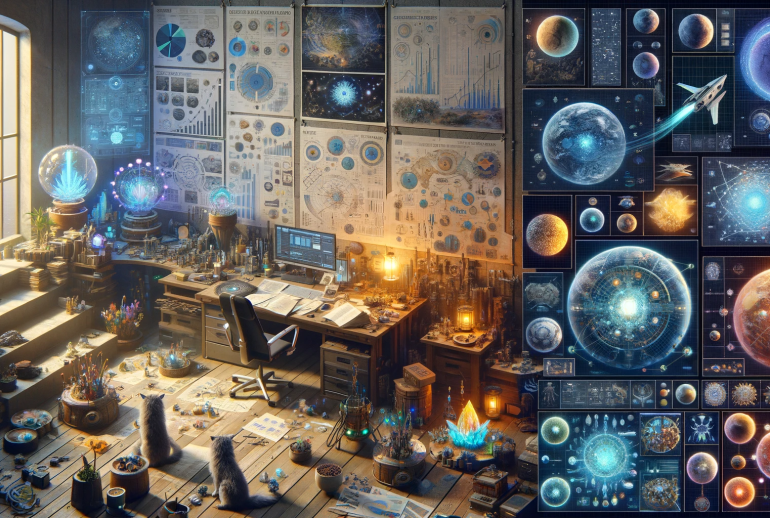World-building in fiction is a canvas of limitless possibilities, where authors paint the backdrop of their stories with intricate details, cultures, and environments. Within this expansive realm, the concept of crossover worlds emerges as a thrilling prospect. It involves the fusion of multiple genres, worlds, or dimensions within a single narrative—a creative endeavor that requires careful planning, artful execution, and a profound understanding of storytelling. In this exploration, we dive into the world of crossover fiction, uncovering the techniques and strategies to seamlessly blend different genres or worlds while maintaining narrative coherence.
The Art of Crossover Worlds
Crossover fiction is a testament to the boundless imagination of authors and the willingness of readers to embark on unique literary journeys. But how does one successfully merge disparate genres or worlds into a cohesive narrative? Let’s unravel the secrets:
1. Embrace Genre Fusion
Genre fusion is at the heart of crossover fiction. It involves the deliberate blending of two or more genres to create a distinctive narrative. Common genre combinations include:
- Fantasy and Mystery: Melding the magical with the investigative, often resulting in fantastical detective stories.
- Science Fiction and Historical Fiction: Combining futuristic technology with the historical past, offering fresh perspectives on both.
- Horror and Romance: Contrasting fear with love, exploring the dark and passionate sides of human nature.
2. Establish a Unifying Theme
A strong thematic thread serves as the backbone of crossover worlds. Whether it’s the power of love, the pursuit of knowledge, or the resilience of the human spirit, a unifying theme helps tie together disparate elements.
3. Develop Complex Characters
Characterization plays a pivotal role in crossover fiction. Create well-rounded characters who are versatile enough to adapt to different genres or worlds. Their motivations and development should align with the overarching narrative.
4. World-Building Consistency
Consistency in world-building is paramount. Ensure that the rules, physics, and logic of each genre or world remain intact. Deviations should be purposeful and explained within the narrative.
5. Seamless Transitions
Transitioning between genres or worlds requires finesse. Avoid abrupt shifts; instead, use gradual transitions or pivotal moments within the story to facilitate genre changes.
Case Study: “The Dark Tower” Series by Stephen King
Stephen King’s “The Dark Tower” series exemplifies the art of crossover worlds. It seamlessly blends elements of fantasy, Western, science fiction, and horror within a single epic narrative. The central character, Roland Deschain, is a gunslinger navigating a post-apocalyptic world filled with magic and technology. King masterfully interweaves these disparate elements, creating a cohesive and gripping saga.
Maintaining Narrative Coherence
Maintaining narrative coherence is the primary challenge of crossover fiction. Here are strategies to ensure your story remains engaging and comprehensible:
1. Balance Genre Elements
Strive for balance between the genres you’re merging. Avoid overwhelming readers with one genre at the expense of others.
2. Character-Driven Plot
A character-driven plot allows readers to connect with the story on a personal level, irrespective of genre shifts. Ensure that character arcs remain central.
3. Foreshadowing and Symbolism
Effective foreshadowing and symbolism can hint at genre shifts and provide readers with subtle clues about the narrative’s direction.
4. Consistent Tone
Maintain a consistent narrative tone throughout the story. Whether it’s dark and brooding or lighthearted and whimsical, a consistent tone helps ground the narrative.
5. Reader Engagement
Engage readers by immersing them in the emotions and experiences of your characters. Regardless of genre, human emotions are a universal bridge.
Challenges and Rewards
Crossover worlds present unique challenges, but the rewards are equally compelling:
Challenges:
Risk of Overcomplication: Merging genres can lead to complex narratives. Strive for clarity to prevent overwhelming readers.
Genre Expectations: Readers bring genre-specific expectations. Managing these expectations while subverting clichés is a delicate balancing act.
Rewards:
Innovation: Crossover worlds invite innovation by pushing the boundaries of traditional genre conventions.
Expanded Audience: Your story can appeal to a broader audience, attracting readers from multiple genres.
Conclusion
Crossover worlds in fiction are a testament to the limitless creativity of authors. They offer readers a literary adventure that transcends boundaries and defies genre limitations. Successfully blending multiple genres or worlds within a single narrative requires careful planning, a unifying theme, complex characters, and consistent world-building. The challenges are met with the rich rewards of innovation and the opportunity to engage a diverse readership. As you embark on your journey into crossover fiction, remember that the art lies in crafting a narrative where the whole is greater than the sum of its genre parts, and where the worlds you create converge seamlessly, inviting readers to explore the breathtaking landscape of your imagination.



